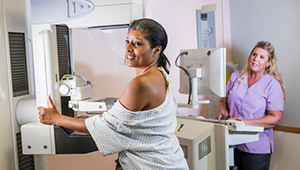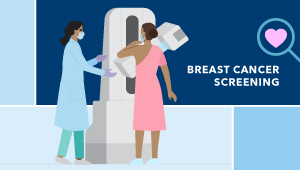Predicting breast cancer risk after a high-risk benign lesion diagnosis

New study will develop risk models to improve clinical guidelines and practice
What happens after a clinician decides that a mammogram or breast lump needs a follow-up examination? Often — more than 1.7 million times a year in the U.S. — the patient has a procedure called a core needle breast biopsy.
About 10% to 15% of these types of biopsies show a high-risk breast lesion that raises concern for current or future cancer. Options for managing these lesions range from more frequent breast imaging to preventive chemotherapy or surgery, including mastectomy. Most surgeries for high-risk lesions do not find cancer, though, creating an opportunity to help clinicians improve their guidance to patients about their options.
"The clinical management of high-risk benign breast lesions poses a dilemma,” said Ellen O’Meara, PhD, a principal collaborative scientist with Kaiser Permanente Washington Health Research Institute (KPWHRI). “Which patients are at high risk of future breast cancer and would benefit from strategies such as enhanced imaging and chemoprevention? Which patients need surgery, and which can be safely managed without it?”
Using BCSC data to develop risk models
O'Meara is one of the leaders of a newly funded study to improve clinical guidelines for managing high-risk benign breast lesions. The project will develop risk models to support clinical guidelines to help physicians guide people with high-risk lesions in managing their condition. The work is funded by the National Cancer Institute with $800,165 to KPWHRI over 5 years.
The study uses data from multiple sources, mainly provided by the Breast Cancer Surveillance Consortium (BCSC), a program that collects data from sites across the country to support breast cancer research. "The BCSC is the best resource for this study because it is a large, geographically diverse consortium with data from radiology facilities, health care systems, pathology databases, and cancer registries," O'Meara said. "Our project will be far larger and more representative of U.S. clinical practice than prior studies of high-risk lesions."
Applying sophisticated statistical methods, the study team will develop and validate risk models to help clinicians determine individual patients' short- and long-term breast cancer risk from high-risk benign breast lesions. The predictions will be based on previous situations in which patients had similar characteristics — such as age, family history of cancer, and lesion features — and did or did not turn out to have or to develop breast cancer.
Ensuring risk models have a positive clinical impact
The risk models will help guide clinical management of high-risk breast lesions, such as whether to choose surgical excision or if the lesion can be safely managed by surveillance imaging.
O'Meara and colleagues know that developing risk-prediction models is not enough. They must ensure that the models affect clinical practice in a way that is acceptable and meaningful to patients, medical professionals, and health care organizations. For that reason, they will model clinical outcomes — such as surgeries avoided and diagnoses delayed — and the expected costs of implementing risk-based management strategies for high-risk benign breast lesions. They will also conduct clinician interviews and patient focus groups for input on the acceptability of risk-based clinical-management strategies.
In the future, O'Meara said, other resources for clinical use might be based on the models developed in their study. "We want to develop risk calculators or other tools that can be readily translated to clinical practice using data routinely available in medical records," she said.
The project principal investigator is Brian Sprague at the University of Vermont. Other KPWHRI collaborators include Project Manager Carolyn Eng, Research Specialist Shaula Levy, and Programmer Chi Tran. Another KPWHRI co-investigator on the project is Erin Bowles, MPH, who is principal investigator of the Kaiser Permanente Washington Breast Cancer Surveillance Registry.
By Chris Tachibana
News

New study: Analysis supports new recommendation to begin mammogram screening at 40
KPWHRI part of multi-site research team.
Research

Roundup of 3 recent studies on breast cancer screening
New research spotlights overdiagnosis, MRI before surgery, and a new way of predicting breast cancer risk


